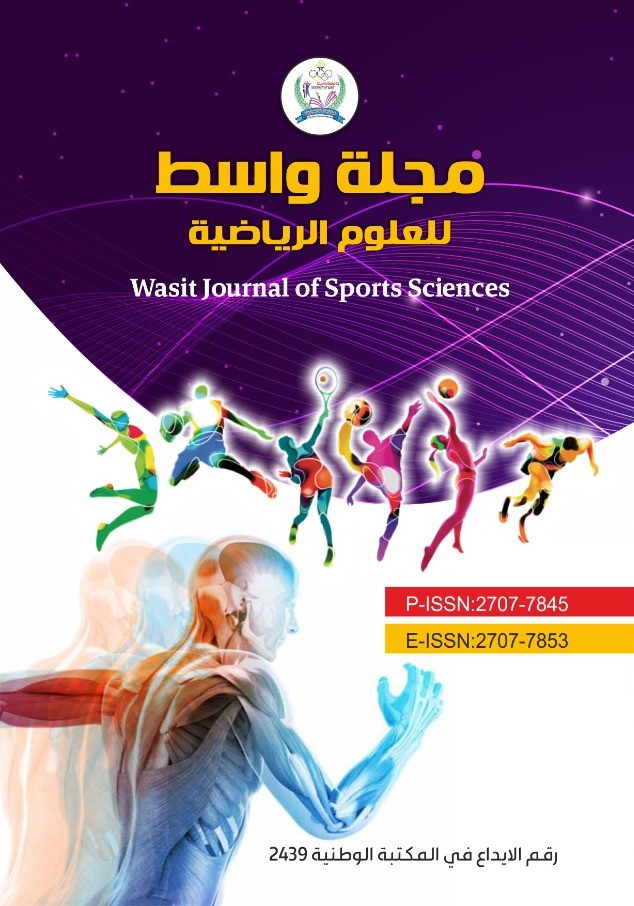Abstract
Many experts in the field of sports confirm that the number of injuries is increasing significantly day by day across various sports due to the high and continuous strain on the systems and organs of the athlete's body. The study aimed to develop rehabilitation exercises integrated with blood flow restriction (BFR) technology to rehabilitate the shoulder dislocation injury in athletes, as well as to determine the effect of these rehabilitation exercises and BFR technology on improving muscle strength, range of motion, and reducing pain levels in the dislocated shoulder joint of athletes. The researchers used the experimental method with pre-test, mid-test, and post-test to suit the nature of the research. The research sample consisted of (10) injured athletes, who were intentionally selected from advanced athletes playing volleyball in clubs in the southern region. The researchers concluded that integrating rehabilitation exercises with blood flow restriction (BFR) technology significantly improved the functional efficiency of the injured shoulder joint in athletes. This was evidenced by a notable increase in the range of motion and the strength of the muscles surrounding the shoulder joint when using rehabilitation exercises with BFR technology, enhancing joint stability and reducing the likelihood of recurring injuries. The researchers also concluded from the results that the use of blood flow restriction (BFR) technology accelerated the healing process and reduced pain compared to traditional methods, allowing athletes to return to their activities more quickly. The researchers recommend emphasizing the use of rehabilitation exercises with blood flow restriction (BFR) technology due to its significant role in healing and reducing the period of absence from sports. They also recommend conducting long-term studies to evaluate the sustainability of the functional improvements provided by blood flow restriction (BFR) technology, and expanding the scope of research to include larger and more diverse samples of athletes from various sports activities.
Keywords
(BFR)
functional efficiency
Rehabilitation exercises
shoulder joint
Abstract
يؤكد الكثير من المختصين في المجال الرياضي أن عدد الإصابات يتصاعد وبشكل متزايد يوماً بعد يوم وبمختلف الالعاب الرياضية نتيجة للجهد العالي والمستمر الواقع على أجهزة وأعضاء جسم الرياضي. وهدفت الدراسة الى اعداد تمرينات تأهيلية مدمجة مع تقنية تقييد تدفق الدم لإعادة تأهيل الكتف المصاب بالخلع لدى الرياضيين، وكذلك معرفة تأثير التمرينات التأهيلية وتقنية تقييد تدفق الدم في تحسين القوة العضلية والمدى الحركي والتقليل من درجة الالم لمفصل الكتف المصاب بالخلع لدى الرياضيين. وقد استخدم الباحثون المنهج التجريبي ذو الاختبار القبلي والوسطي والبعدي لملائمته لطبيعة البحث. وتكونت عينة البحث من (10) مصابين تم اختيارهم بالطريقة العمدية من الرياضيين المتقدمين المصابين الذين يلعبون في اندية المنطقة الجنوبية بالكرة الطائرة. واستنتج الباحثون أن دمج التمرينات التأهيلية مع تقنية تقييد تدفق الدم (BFR)قد ساهم بشكل ملحوظ في تحسين الكفاءة الوظيفية لمفصل الكتف المصاب لدى الرياضيين من خلال زيادة ملحوظة في المدى الحركي وقوة العضلات المحيطة بمفصل الكتف عند استخدام التمرينات التأهيلية مع تقنية تقييد تدفق الدم، مما يعزز من استقرار المفصل ويقلل من احتمالية تكرار الإصابة، واستنتج الباحثون ايضا من النتائج التي تحصلوا عليها أن استخدام تقنية تقييد تدفق الدم (BFR) أدى إلى تسريع عملية الشفاء وتقليل الالم مقارنة بالطرق التقليدية، مما يسمح للرياضيين بالعودة إلى نشاطاتهم بشكل أسرع. ويوصي الباحثون بالتأكيد على استعمال التمرينات التأهيلية مع تقنية تقييد تدفق الدم (BFR) لما لها من دور كبير في الشفاء وتقليل فترة الابتعاد عن الرياضة، كما يوصون بإجراء دراسات طويلة المدى لتقييم استدامة التحسينات الوظيفية التي توفرها تقنية تقييد تدفق الدم (BFR)، وتوسيع نطاق البحث ليشمل عينات أكبر وأكثر تنوعًا من الرياضيين ومن مختلف الفعاليات الرياضية.
Keywords
التمرينات التأهيلية
الكفاءة الوظيفية
تقييد تدفق الدم (BFR)
مفصل الكتف
